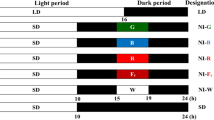Abstract.
Diurnal changes in carbohydrates and nitrate reductase (NR) activity were compared in tobacco (Nicotiana tabacum. L.cv. Gatersleben) plants growing in a long (18 h light/6 h dark) and a short (6 h light/18 h dark) day growth regime, or after short-term changes in the light regime. In long-day-grown plants, source leaves contained high levels of sugars throughout the light and dark periods. In short-day-grown plants, levels of sucrose and reducing sugars were very low at the end of the night and, although they rose during the light period, remained much lower than in long days and declined to very low levels again by the middle of the night. Starch accumulated more rapidly in short-day- than long-day-grown plants. Starch was completely re-mobilised during the night in short days, but not in long days. A single short day/long night cycle sufficed to stimulate starch accumulation during the following light period. In long-day-grown plants, the Nia transcript level was high at the end of the night, decreased during the day, and recovered gradually during the night. In short-day-grown plants, the Nia transcript level was relatively low at the end of the night, decreased to very low levels at the end of the light period, increased to a marked maximum in the middle of the night, and decreased during the last 5 h of the dark period. In long-day-grown plants, NR activity in source leaves rose by 2- to 3-fold in the first part of the light period and decreased in the second part of the light period. In short-day-grown plants, NR activity was low at the end of the night, and only increased slightly after illumination. Dark inactivation of source-leaf NR was partially reversed in long-day-grown plants, but not in short day-grown plants. In both growth regimes, mutants with one instead of four functional copies of the Nia gene had a 60% reduction in maximum NR activity in the source leaves, compared to wild-type plants. The diurnal changes in NR activity were almost completely suppressed in the mutants in long days, whereas the mutants showed similar or slightly larger diurnal changes than wild-type plants in short days. When short-day-grown plants were transferred to long-day conditions for 3 d, NR activity and the diurnal changes in NR activity resembled those in long-day-grown plants. Phloem export from source leaves of short-day-grown plants was partially inhibited by applying a cold-girdle for one light and dark cycle. The resulting increase in leaf sugar was accompanied by an marked increase in the Nia transcript level and a 2-fold increase in NR activity at the end of the dark period. When wild-type plants were subjected to a single short day/long night cycle of increasing severity, NR activity in source leaves at the end of the night decreased when the endogenous sugars declined below about 3 μmol hexose (g FW)−1. In sink leaves in short-day conditions, sugars were higher and the light-induced rise in NR activity was much larger than in source leaves on the same plants. The source leaves of wild-type plants in short-day conditions contained very high levels of nitrate, very low levels of glutamine, low levels of total amino acids, and lower protein and chlorophyll, compared to long-day-grown plants. Plants grown in short days had relatively high levels of glutamate and aspartate, and extremely low levels of most of the minor amino acids in their source leaves at the end of the night. Illumination led to a decrease in glutamate and an increase in the minor amino acids. A single short day/long night cycle led to an increase in glutamate, and a large decrease in the minor acids at the end of the dark period, and re-illumination led to a decrease in glutamate and an increase in the minor amino acids. It is proposed that sugar-mediated control of Nia expression and NR activity overrides regulation by nitrogenous compounds when sugars are in short supply, resulting in a severe inhibition of nitrate assimilation. It is also proposed that sugars exert a global control on amino acid metabolism. The importance of sugars for the regulation of nitrogen metabolism is strikingly illustrated by the finding that tobacco is carbon and nitrogen limited when it is grown in short-day conditions.
Similar content being viewed by others
Author information
Authors and Affiliations
Additional information
Received: 6 January 1998 / Accepted: 27 April 1998
Rights and permissions
About this article
Cite this article
Matt, P., Schurr, U., Klein, D. et al. Growth of tobacco in short-day conditions leads to high starch, low sugars, altered diurnal changes in the Nia transcript and low nitrate reductase activity, and inhibition of amino acid synthesis. Planta 207, 27–41 (1998). https://doi.org/10.1007/s004250050452
Issue Date:
DOI: https://doi.org/10.1007/s004250050452




